Models 190 to 198
Skip information indexModel 193 Submission by form
Form 193 can be submitted using the web form available on the Electronic Office; It allows the declaration to be completed, validated, and stored in the cloud to recover the work session at another time, as well as submitting the correct records included in the declaration.
Please note that the web form is available if the return contains up to 40,000 records. If you exceed this threshold, you will need to use the file submission option.
Filing online requires identification with an electronic certificate, DNIe eitherCl@ve of the declarant. In addition to the holder of the declaration, it may also be submitted by a third party acting on his or her behalf, whether it be a social collaborator or a representative to carry out the procedure.
We recommend that you clean up the census of your recipients using the tax identification service before filing your return to avoid identification errors. To do this you can use the option available on the website: "Verification of a NIF of third parties for census purposes" located in "Help", "Tax identification" in the "2024 informative declaration campaign" section.
This query is also found in the procedures for model 030 within "Census, NIF and tax address".
After logging in, in the pop-up window, choose one of the options to access the form:
- Continue. It allows you to create a new declaration by entering all the data. Enter the NIF of the declarant and click "Continue".
- Matter. You can import a file with format BOE that follows the registration design of the current model 193, obtained with the form itself by exporting the declaration or with an external program. The registration limit will be 40,000;
- Import previous year . The data from the previous year will be imported from the active records of the previous year at the time of the query. To do this, you must access the form with an electronic certificate, electronic DNI or Cl@ve of the declarant, social collaborator who filed the declaration the previous year or a representative who had filed the declaration the previous year or a representative at the query of the declaration. It is not possible to import data from the previous year if the declaration exceeds 40,000 records. Please note that once the declaration has been submitted, this option will no longer be available.
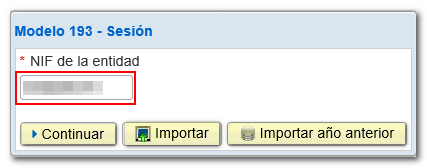
If there is a saved work session or a previously submitted statement, the application will show you the available options:
- In case there is a saved but unsubmitted work session and you want to recover it, check the box " Load the work session from dd/mm/yyyy ";
- If you have filed a return and wish to make changes to it, such as: lower, modify or add records, check the box " Upload the declaration submitted on dd/mm/yyyy hh:mm:ss ";
- To create a new declaration, check the box " Create a new declaration ".
Select an option and press "Continue".
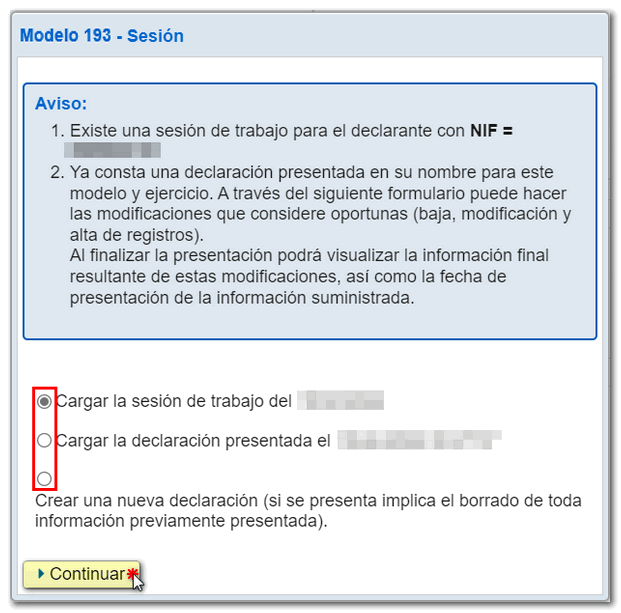 When registering a new declaration you must select the type of modality, "Normal" or "Simplified"; Please note that this selection cannot be modified later and determines the rest of the completion. Click "Accept".
When registering a new declaration you must select the type of modality, "Normal" or "Simplified"; Please note that this selection cannot be modified later and determines the rest of the completion. Click "Accept".

If it is a new declaration, in the first window, "Declarant data - Normal declaration" or "Declarant data - Simplified declaration", fill in the boxes marked with an asterisk as they are mandatory. The boxes in the "Summary of data included in the declaration" fields are automatically filled in with the data entered in the "Recipients" and "Expenses" sections.
To modify a declaration already submitted, load the declaration submitted in the initial window by selecting "Upload the declaration submitted on dd/mm/yyyy hh:mm:ss" and, within the "Receivers" or "Expenses" tab, make the changes you need: cancel and modify existing records or create new records.

After completing the declarant's data, from the " Sections " tab, access the recipients and expenses. If the selected option is "Simplified", there will only be the option for recipients (there are no costs).
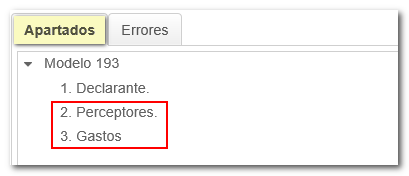
In section "Recipients" or "Expenses" you will find a button panel from which you can register, cancel and navigate between recipients or expenses. To register a recipient or expense, click on the "New record" icon.
If you have registered several recipients or expenses, to view a specific one, select it and click "View recipient" or "View expense".

If you have uploaded a previously submitted return, the "Submitted on" column will show the date and time that record was submitted, with the option to modify or delete it if necessary.

Once you have completed the data for a record, in this same window you can add, delete and move between them or return to the list of recipients or expenses from the "View list of recipients" or "View list of expenses" button.
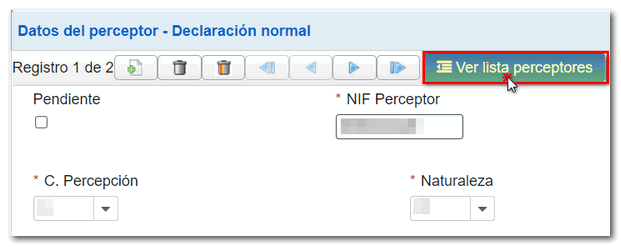
In the list of recipients and expenses, the column " Status " has been enabled where you can check the correct and incorrect records by the icon.

From the list of recipients or expenses, you can make queries by establishing filtering criteria. Click " Query " at the top, in the new window set the filter criteria and click "Query".

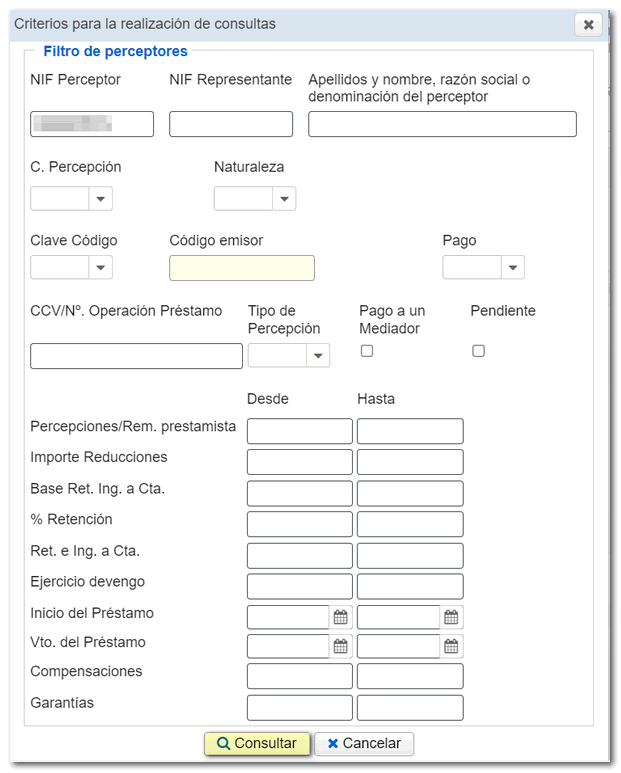
A new tab will be activated at the bottom called "Query" next to the "Sections" and "Errors" tabs with the information according to the established criteria. The record information is spread across a single row across the width of the form, so it is necessary to use the horizontal scroll bar to view the rest of the fields. However, double-clicking on any of the results displays the record information at the top of the form.
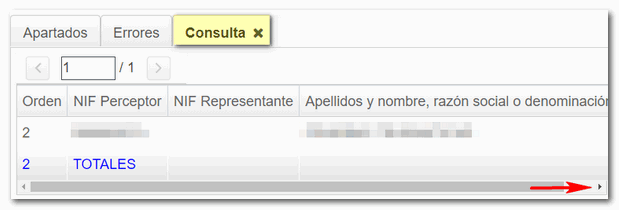
At the bottom of the screen are the options available in the form. If you do not see the buttons or sections correctly, check the font size and zoom configured in your browser.
To check if there are errors in the declaration, press the " Validate " button. If it contains errors or warnings, the "Errors" tab will be enabled with the description of the error or warning and the "Go to Error" or "Go to Warning" button, as appropriate, which will take you to the box to modify or complete. Using the "Download error list" option, a file in XML format will be generated with all the errors detected, which you can open or save on your computer.
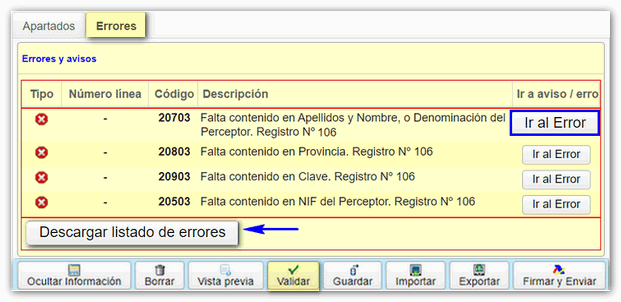
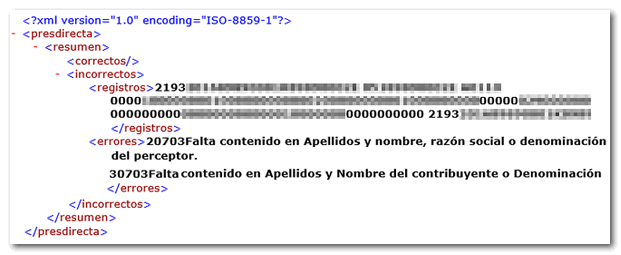
If the declaration is correct you will get the message "No errors".

Additionally, if you want to obtain a draft to review the data before filing your return, you have the " Preview " tool to generate a PDF that is not valid for filing with your return. The PDF is displayed on the screen; However, from the link "click here to download the pdf" it is possible to download it to your computer; Please note that to correctly view the draft you need a PDF viewer, we recommend the latest version compatible with your operating system. To return to the declaration, click "Return to declaration" at the top of the draft window or generate a "New declaration".

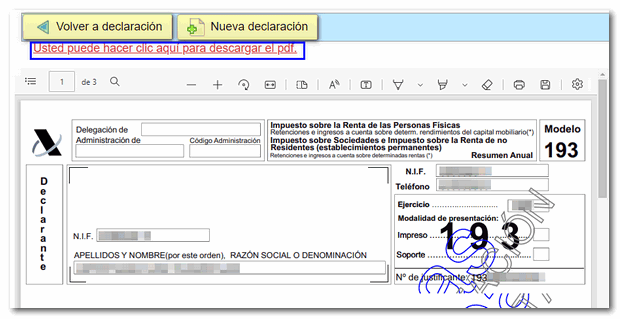
The option " Save " allows you to store the data completed up to that point on the AEAT servers, even if it is not validated (it may contain errors or be incomplete), if there is already a previously saved declaration it will be overwritten. The recovery of this data is done by accessing the web form again by clicking "Continue", once the NIF has been entered, if there is a declaration saved for that NIF the server will detect it and will give you the option to recover it by checking "Load the work session of dd/mm/yyyy".

The form has a timeout due to inactivity, we recommend that you save the declaration to avoid data loss.
Using the " Export " button you can generate a file with the format of the published logical design, provided that the declaration does not contain errors, and save it in the path you want. This file has the name NIF and the extension .193. You can recover this file by accessing the web form again and clicking " Import " in the bottom button bar or in the initial window.
 The "Import" button allows you to import a file, which has been created following the current registry layout. Click "Import" and select the file.
The "Import" button allows you to import a file, which has been created following the current registry layout. Click "Import" and select the file.

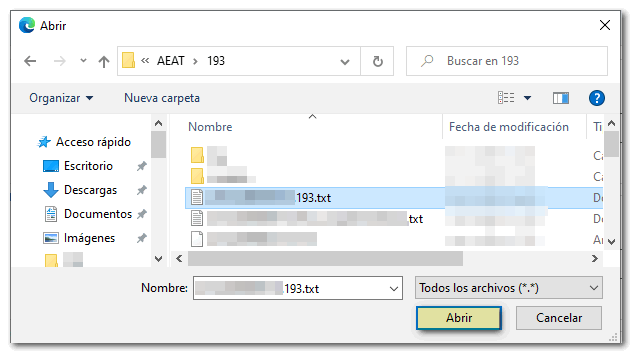
Once you have selected the file, the application will offer you two options:
- A - Delete all Recipient and Expense records and import . With this option you will delete the entire current declaration and obtain a new declaration with the data that was in the imported file.
- B - Add Recipient and Expense records to the current return . This way you will keep the current declaration and add the new records to the existing ones.

The " Help " button provides you with a PDF with the regulations and information regarding the model as well as the deadline, form and place of presentation and the registration design of model 193.
After validating and saving the declaration, you can submit it by clicking the " Sign and Send " button. In the new window, check the "Accept" box to confirm the filing of the declaration. The text box will display the encoded content of the declaration. Finally, click "Sign and Send" to continue with the presentation.

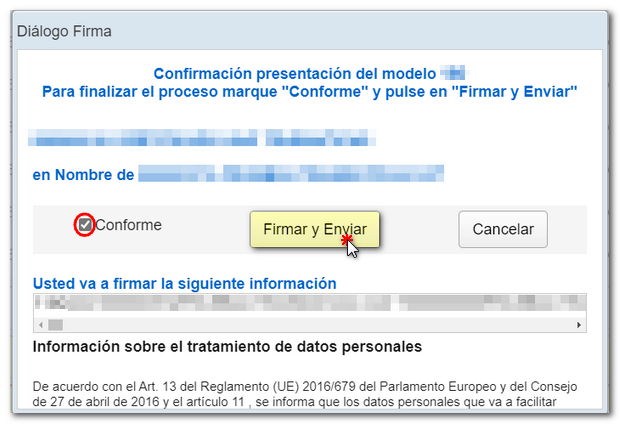
The result of a successful submission will be a response page with an embedded PDF containing a first page with the submission information (registration entry number, Secure Verification Code, receipt number, day and time of submission and presenter information).
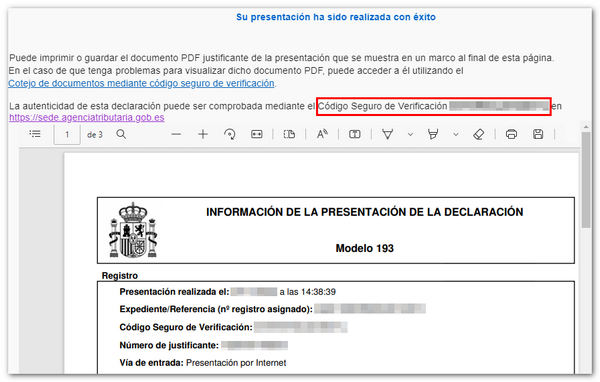
However, if when filing the return, there are some correct and other incorrect records, only the correct records may be submitted. If you want to submit the correct ones, click "Yes". You will then need to return to the declaration, correct the errors and resubmit the complete declaration, including all records: both those already submitted and those pending. 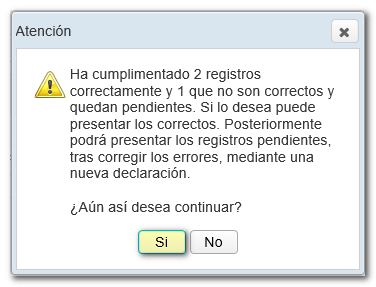
After submitting the correct records, you will receive the PDF , in a new window, with proof of submission and a summary of the data from the declaration submitted with the totals of correct records.

Click "Return to declaration" and you will see that the complete declaration has been loaded with all the records, both correct and incorrect.
Correct any incorrect records and, if you wish, delete records or add new records. Validate the declaration and resubmit the complete declaration with all the records, that is, those previously submitted correctly plus those modified and/or those you have added.